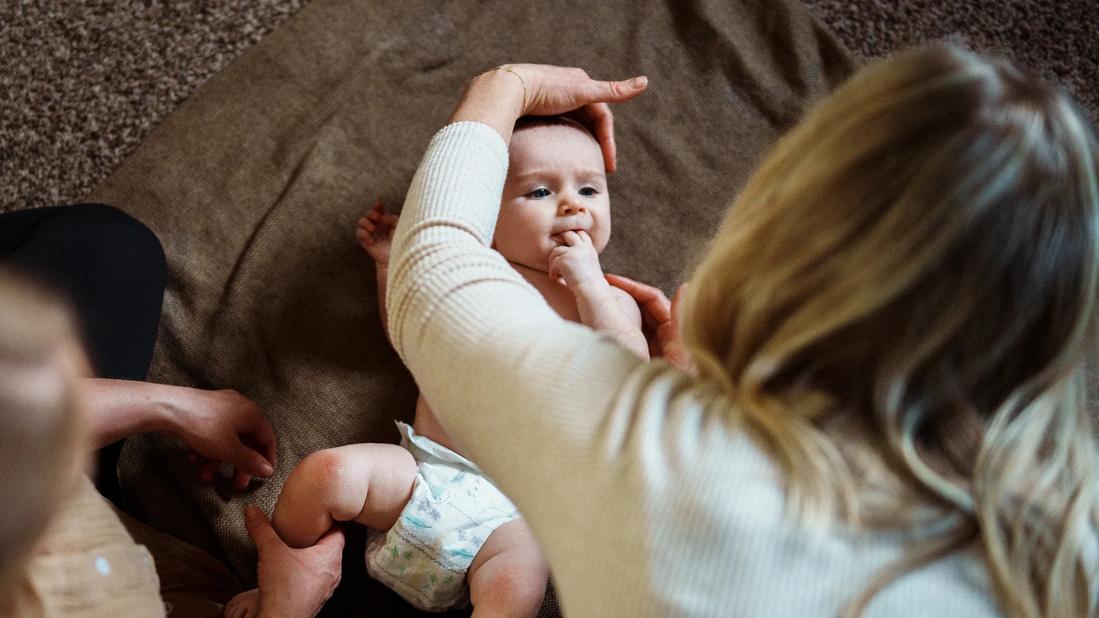When tight neck muscles give your newborn a head tilt, these gentle exercises can go a long way

Torticollis means “twisted neck” in Latin, and as you might expect from that terminology, it’s a condition that can be alarming to spot in your newborn baby.
Advertisement
Cleveland Clinic is a non-profit academic medical center. Advertising on our site helps support our mission. We do not endorse non-Cleveland Clinic products or services. Policy
When the “strap muscles” in your baby’s neck become short and tight, whether from birth trauma or their position in the uterus, it can pull their head to one side and give them a tilted appearance.
“Torticollis can be frightening for parents,” says pediatrician David Burke, DO, “but most kids do very well, especially when torticollis is identified early and treated quickly.”
He explains what you can do to help relieve your baby’s torticollis.
“Torticollis will often self-correct when treated early — ideally, within the first month or two,” Dr. Burke says.
Doing gentle stretching exercises several times each day can help loosen and lengthen your baby’s sternocleidomastoid muscle (SCM), which runs from the collarbone to behind the ear.
“Parents can begin home exercises immediately,” says pediatrician Penina Gross-Richmond, DO. “Your pediatrician will explain how to do stretches with your baby and how to reposition them and do light massage. They also refer you to physical therapy or an osteopathic physician.”
Doing gentle stretches with your baby throughout the day may help them achieve full range of motion in their neck. Be sure to go into it with these tips in mind:
Advertisement
These stretches can be done during playtime, after bath time or when your baby is lying flat on the changing table after a diaper change.
Before you start, one more thing to know:
Now, let’s begin.
This gentle stretch helps lengthen the muscles on the tight side of your baby’s neck.
For right-sided torticollis:
For left-sided torticollis:
“This stretch helps improve your baby’s range of motion on the tight side of their neck,” Dr. Gross-Richmond clarifies.
For right-sided torticollis:
For left-sided torticollis:
Stretches aren’t the only way to relieve torticollis. These other at-home strategies should accompany your efforts.
“Repositioning is when you turn your baby so they’re facing the opposite direction from the one they want to turn to,” Dr. Gross-Richmond explains. “For example, if you place your baby in their crib so they’re facing the wall, they’ll have to activate the muscles on the other side of their neck in order to see you at the bedside.”
Advertisement
Repositioning encourages active neck rotation to help loosen the muscles in the side of your baby’s neck that’s tight. You can practice these techniques with your baby throughout the day:
Tummy time encourages babies to turn their heads from side to side, push up on their arms and increase their muscle tone.
“We recommend it for all babies, but tummy time can correct mild cases of plagiocephaly and help make babies’ heads nice and round,” Dr. Burke notes.
Do tummy time several times a day, increasing the time increments as your baby learns to tolerate it. Tummy time is an important piece of the treatment for torticollis because normal developmental positions help with realignment.
Advertisement
You can lightly massage your baby’s neck and back muscles to help loosen them. Ask their pediatrician for tips on doing it safely or for recommendations to another professional who can help.
“Osteopathic physicians can do manipulative therapy, using gentle, hands-on techniques to guide tissues into a more relaxed position,” Dr. Burke says. “This allows the neck to straighten by restoring alignment and releasing tissue tightness.”
Dr. Gross-Richmond explains further: “By gently addressing the bones at the base of the skull where the tight muscles attach, osteopathic manipulative therapy offers an effective treatment that goes beyond muscle stretching to the root of the issue.”
If your baby’s head tilt is significant, or if at-home stretches don’t work, they may need physical therapy to relieve the condition. Often, osteopathic manipulative treatment is an effective complement to physical therapy and at-home interventions. Left uncorrected, torticollis can:
If your baby has a head tilt and you suspect they could have torticollis, speak to their pediatrician ASAP. Treatment can take longer after they’re 3 months old, so the message is clear: “If you have concerns, talk to your pediatrician sooner rather than later,” Dr. Gross-Richmond urges. “This will give your baby plenty of time for treatment and timely referrals, if needed.”
Advertisement
Learn more about our editorial process.
Advertisement

Babies can be noisy little sleepers! Blame small nasal passages and short sleep stages

Yes, you can have honey if you’re breastfeeding — but never feed it directly to babies under 1

Earlobe piercings heal quicker and are less painful than cartilage piercings — proper cleaning and care are important

We don’t fully understand how cleanliness impacts immune system development, but we do know that preventing illness is important

Most kids get enough protein in a regular diet — too much can have side effects

Keep kids safe while they swim by staying vigilant and setting up a safe pool environment

Once your baby’s eyes are exposed to more light, they may start to deepen in hue or change color altogether, usually between 3 and 9 months

This child development strategy is all about meeting your child where they are

If you’re feeling short of breath, sleep can be tough — propping yourself up or sleeping on your side may help

If you fear the unknown or find yourself needing reassurance often, you may identify with this attachment style

If you’re looking to boost your gut health, it’s better to get fiber from whole foods